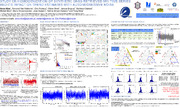Por favor, use este identificador para citar o enlazar este ítem:
http://hdl.handle.net/20.500.11765/11986
Study on homogenization of synthetic GNSS-Retrieved IWV time series and its impact on trend estimates with autoregressive noise
| Título : | Study on homogenization of synthetic GNSS-Retrieved IWV time series and its impact on trend estimates with autoregressive noise |
| Autor : | Klos, Anna; Van Malderen, Roeland; Pottiaux, Eric; Bock, Olivier; Bogusz, Janusz; Chimani, Barbara; Elias, Michal; Gruszczynska, Marta; Guijarro Pastor, José Antonio


|
| Palabras clave : | Integrated Water Vapour; Global Positioning System; International GNSS Service |
| Fecha de publicación : | 2017 |
| Citación : | EGU General Assembly (2017) |
| Resumen : | A synthetic benchmark dataset of Integrated Water Vapour (IWV) was created within the activity of “Data homogenisation” of sub-working group WG3 of COST ES1206 Action. The benchmark dataset was created basing on the analysis of IWV differences retrieved by Global Positioning System (GPS) International GNSS Service (IGS) stations using European Centre for Medium-Range Weather Forecats (ECMWF) reanalysis data (ERA-Interim). Having analysed a set of 120 series of IWV differences (ERAI-GPS) derived for IGS stations, we delivered parameters of a number of gaps and breaks for every certain station. Moreover, we estimated values of trends, significant seasonalities and character of residuals when deterministic model was removed. We tested five different noise models and found that a combination of white and autoregressive processes of first order describes the stochastic part with a good accuracy. Basing on this analysis, we performed Monte Carlo simulations of 25 years long data with two different types of noise: white as well as combination of white and autoregressive processes. We also added few strictly defined offsets, creating three variants of synthetic dataset: easy, less complicated and fully complicated. The synthetic dataset we present was used as a benchmark to test various statistical tools in terms of homogenisation task. In this research, we assess the impact of the noise model, trend and gaps on the performance of statistical methods to detect simulated change points. |
| Descripción : | Póster presentado en: EGU General Assembly celebrada del 23 al 28 de abril de 2017 en Viena, Austria. |
| URI : | http://hdl.handle.net/20.500.11765/11986 |
| Colecciones: | EGU General Assembly |
Ficheros en este ítem:
| Fichero | Descripción | Tamaño | Formato | ||
|---|---|---|---|---|---|
| EGU2017AKposter.pdf | 2,37 MB | Adobe PDF |  Visualizar/Abrir |
Los ítems de Arcimis están protegidos por una Licencia Creative Commons, salvo que se indique lo contrario.





